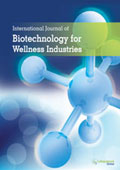ijbwi
Abstract : MarA, SoxS and Rob of Escherichia coli – Global Regulators of Multidrug Resistance, Virulence and Stress Response
|
|
Abstract: Bacteria have a great capacity for adjusting their metabolism in response to environmental changes by linking extracellular stimuli to the regulation of genes by transcription factors. By working in a co-operative manner, transcription factors provide a rapid response to external threats, allowing the bacteria to survive. This review will focus on transcription factors MarA, SoxS and Rob in Escherichia coli, three members of the AraC family of proteins. These homologous proteins exemplify the ability to respond to multiple threats such as oxidative stress, drugs and toxic compounds, acidic pH, and host antimicrobial peptides. MarA, SoxS and Rob recognize similar DNA sequences in the promoter region of more than 40 regulatory target genes. As their regulons overlap, a finely tuned adaptive response allows E. coli to survive in the presence of different assaults in a co-ordinated manner. These regulators are well conserved amongst Enterobacteriaceae and due to their broad involvement in bacterial adaptation in the host, have recently been explored as targets to develop new anti-virulence agents. The regulators are also being examined for their roles in novel technologies such as biofuel production. Keywords: Antibiotic resistance, AraC family regulators, Escherichia coli, Enterobacteriaceae, global regulators, drug development.Download Full Article |
Abstract : Effect of Carbon Dioxide Concentration on the Growth Response of Chlorella vulgaris Under Four Different Led Illumination
|
|
Abstract: This experiment examined the growth response of Chlorella vulgaris exposed to CO2 concentrations increasing from ambient to 8.5% and under white, blue, red and red-blue lights after 15 days incubation. Biomass production increased with increasing CO2 concentrations under all light sources. The highest biomass production, 1.59 g L-1, was obtained when the algae were supplied with 8.5% CO2 and exposed to white light. Biomass production under blue, red and red+blue light was 1.53 g L-1, 0.45 g L-1 and 1.27 g L-1, respectively. The research suggests that C. vulgaris is not able to adapt production of its photosynthetic pigments to absorb light sources different that it is normally has evolved to. Keywords: Chlorella vulgaris, Photobioreactor,Biomass production, CO2 concentration, Artificial light.Download Full Article |
Abstract : Colon Cancer Reversed by Phyto-Nutritional Therapy: A Case Study
|
|
Abstract: Colorectal cancer is the second most common cancer in Malaysia and up to 80% of its patients seek complementary therapies. Globally, up to 95% of cancer patient use adjunct therapies to reduce chemotherapy-induced side-effects. Morgan et al. (2004) had showed that conventional treatment for colon cancer produced minimal results. The vast majority of cancer survivors admitted to using dietary supplements and herbs after their cancer diagnosis. Current treatment seems to pay more attention to cancer as a disease rather than meeting the physiological needs of the patient. Nutritional therapy should be individually tailored since dietary deficiency is multifactorial and the tumor burden for each patient is different. Cancer is a metabolic disorder and colon cancer is strongly associated with advancing age, dietary and lifestyle habits. Up to 90% of all cancers might be prevented with proper nutrition since one-third of overall cancer deaths are linked to malnutrition. This case study shows how a late stage colon adenocarcinoma might be completely reversed by evidence-based phyto-nutritional therapy combined with some lifestyle modifications. The cancer apoptotic properties of this natural protocol warrant further investigation involving a higher number of patients with similar conditions. Keywords: :Colon cancer, metabolic disorder, complementary medicine, phyto-nutritional therapy, apoptosis.Download Full Article |
Abstract : Fe(III)-Chloroquine Complex: A New Potent Compound in Wellness Industries of High Antimicrobial and Antimalarial Activities
|
|
Abstract: Fe(III)- Chloroquine complex has been synthesized and screened for its physicochemical, microbial as well as pharmacological activity have been done in solid and aqueous phase. On the basis of elemental analysis, polarographic studies, amperometric titration and IR spectral studies the probable formula for the complex has been determined at 25±1OC and ionic strength of µ= 1.0[KCl]. Raper’s paper disc method was used for microbial study against various pathogenic bacteria and fungi. In vivo syudy of Swiss mice [25-30gm] were used for antimalarial activity against Chloroquine and its complex on xyline-Alcoholic activity test Kidney, liver and serum of these rats were also studied. On the basis of observed result it could be concluded that Fe (III)-Chloroquine complex were found to be non-toxic and more potent than pure chloroquine drug. Keywords: :Fe (III) – Antimicrobial activity, Antimalarial activity, in vivo study.Download Full Article |























